

The one thing you will not find in school—or even on Architecture Registration Exams—is a course on how to get work, yet it is one of the most basic needs of any design practice. In fact, if you don't have an equal ability to experiment in getting work as you do in doing work you would be fortunate to make it past the first five years.
UpStarts are a series of features on the foundations of contemporary practice. It will have a global reach in which practices from Europe, North America, Asia, and beyond will be asked to address the work behind getting the work, and the effect of cultural contexts. The focus will be on how a practice is initiated and maintained. In many ways, the critical years of a fledgling design partnership is within the initial five years, after the haze and daze of getting it off the ground. UpStarts will survey the first years of practice as a tool for tracking the tactics of the rapidly evolving methods for sustaining a practice.
Archinect's chief editor John Jourden talks to London-based Plasma Studio
A few months ago, I attended the inaugural event for the opening of Extension, an architecture gallery promising to create an experimental forum for architecture in a city of stagnation. To kick off its first event, Extension turned to the young British firm Plasma Studio to christen its space with an installation. Although armed with a longer tour of duty on the front lines of praxis than some of our previous UpStarts features, Plasma Studio is at the cusp of a more revealing time in the life of an emerging practice. Its partners, Holger Kehne and Eva Castro, have had incredible success for such a young firm with all the functional moires of running their maturing studio since its founding in 1999. I spoke to Holger Kehne over lunch with his faithful project architect Peter Pichler at the Artist Café on South Michigan Avenue after we had scoured the loop on my abridged twenty-minute architectural tour.
0:36 jourden:// For Plasma Studio was there a particular moment where you knew it was right for you guys to start—how did it begin?
0:48 kehne:// Yeah, we needed to work with some other practices to first build some experience, but somehow it wasn’t an option—it was a bad time to find jobs somehow. Our portfolios didn’t have many practical things; it was all quite conceptual work for both of us, so there weren’t many opportunities to get many proper jobs.
Then some neighbors came around who wanted to do a little project. These neighbors wanted to do a canopy for a building they owned in the city of London. We went there and we said, “You don’t need a canopy. You need something else—this is another sort of problem.” And that became a proper project. We started further from there, mostly completing smaller scales projects, but nevertheless we were experimentally able to explore and express our ideas through our projects. It was very tough I think—to do that—to start up without having any of the experience that helps you along. You make the mistakes on your own very clearly. Also, financially very, very tough, but than eventually it picked up a little and things became comparatively more comfortable.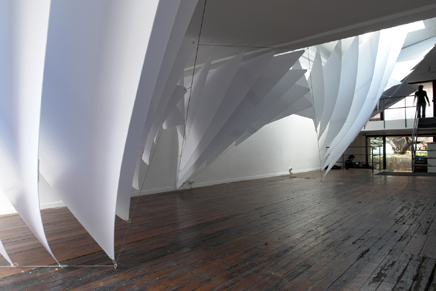
G3 installation for Extension (2006) Plasma Studio
2:28 jourden:// In 2002, you were awarded the YAYA (Young Architect of the Year Award ) did this have an effect on the progress of your practice? Do you think awards are helpful for young practices to establish themselves? Or should you just avoid them all together?
2:45 kehne:// Well first of all, most obviously, winning is always good, no? It was quite a prestigious thing at the time, but I think it’s sort of watered down now—only for British practices and so on. But this project was only having foreigners winning it. [laughs] So now they’ve kind of restricted it. Even though now, we are in that sense a British practice, but they were not that happy about it.
Winning it, I think it wasn’t as good as people said it would to be. People said, "Oh this is going to put you on the map. This is going to get you projects." And it didn’t really do it, definitely not to that level. The bit like the publications was good. Being published everywhere and so on, but it sort of doesn’t bring you directly any benefit. In that sense, people shouldn’t pin their hopes too high up for these things, but I think still participating in them is probably a good idea, because of the discussion they bring up…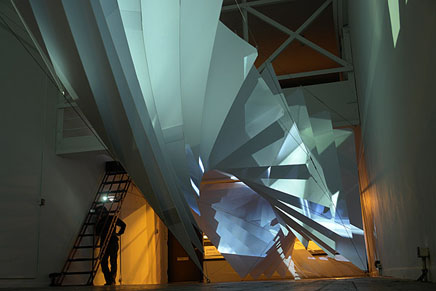
G3 installation for Extension (2006) Plasma Studio
4:06 jourden:// Do you think that Britain sort of has an aversion toward foreign architects? For example, Zaha has had so many problems—she is only now recently completing projects there. Do you think you’ve run into some of the same obstacles?
4:19 kehne:// It’s not because we are foreign. But only in such a way that we don’t have connections—family connects and so on. I think that would help, but that would help everywhere. Obviously we don’t have that. But otherwise, London is actually quite open to foreigners doing whatever they want. It’s more that we’re an experimental and conceptual practice and they’re not up for that really. It is this sort of style of things for which they’re pretty pragmatic over there. They’re more concerned with thinking of property as business, as making money, and its kind of the short-term thought. And therefore it’s unusually where we are utilized for that particular purpose.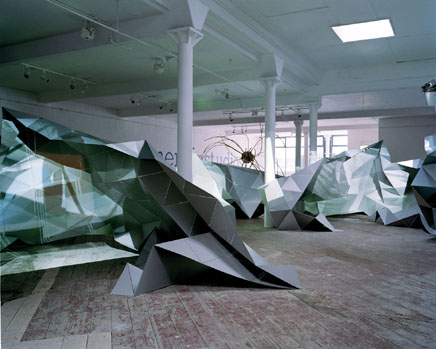 Crumple Zone installation for FACTIO (2004) Plasma Studio
Crumple Zone installation for FACTIO (2004) Plasma Studio
5:20 jourden:// Early on in your career, your partner Eva Castro described London as a “good place to project from, but very difficult to develop” because the density and context of the city limit young architects, restricting them to more sorts of restoration and remodeling projects. Considering the recent building boom in London and now that you have some years under your belts, has it changed for you?
5:45 kehne:// No, I don’t think it will, because it is a specific place where the projects have such a high value that you’re confronted with either you have to build something big and quite generic really, that works for all kinds of people or, it’s some sort of housing association doing things with a cutthroat budget, and then it’s really mediocre stuff they’re seeking. I don’t really see opportunities for us, or at least not very many. You never know though, there might be some private firms who want something special, something different, but this wouldn’t be the norm. It would be something extraordinary to happen.
In that sense it’s not a good place for us to work, but you never know, things could turn around a little. The other thing that really scares me is even now we (London) don't have many projects, just very small things actually. I’m afraid at the state of it in comparison to many other countries across the world: Italy, Germany, India, China, everywhere…the United States has some major museums and things, and in Britain it’s not really happening…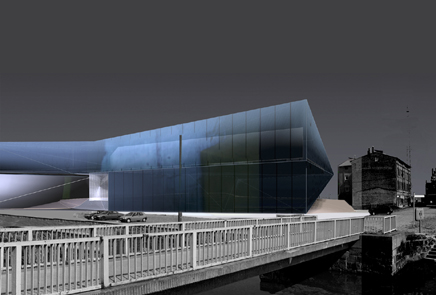 German Oceanographic Museum , Stralsund (2002) Plasma Studio
German Oceanographic Museum , Stralsund (2002) Plasma Studio
7:22 jourden:// Is that because the avant-garde there is still embedded in a Kaplicky , Rogers , Foster mold, this kind of formal upright British sort of way of thinking or what?
7:37 kehne:// Yeah, that is sort of a clever way for them to circumvent and to work from the realm of functionalism —to work out an argument, which the people can relate to. It’s not an intellectual discussion about space and society, but rather one more about efficiency and pragmatism and so on. From that level you can get quite a good discussion going, but it’s sort of limited to a certain mode of discourse.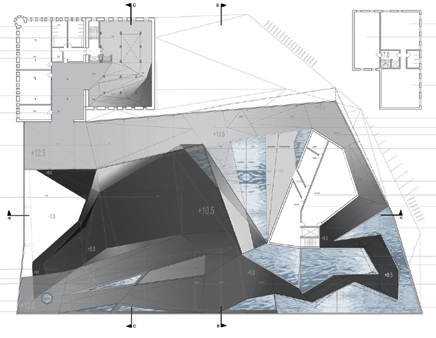 German Oceanographic Museum , Stralsund (2002) Plasma Studio
German Oceanographic Museum , Stralsund (2002) Plasma Studio
8:28 jourden:// So both you and your partner (Castro) teach at the AA , and it seems like many young architects working today find that the academy is a increasingly good position from to engage and develop ideas. What is your relationship to teaching and practice? Does teaching aid in creating new methods and new practices in your office?
8:37 kehne:// For sure! I think teaching and its relation to practice really compliment each other. And for us it can never be only one, because it’s a reciprocal kind of relationship that moves things forward by engaging in very similar ideas, but in totally different mediums—totally different worlds that are moving in the same direction really. This allows us to explore ideas through different levels and this comes back through the practice. We wouldn’t do what we are doing right now, if we weren’t teaching. But at the same time teaching can easily take over. You have to be a bit careful that it doesn’t take over the whole process; practically it helps to keep your feet on the ground a little. But we are fortunate at the AA that we can pursue quite a lot of things and really do it the way we want. I think we are always going to keep teaching as a part of what we do somehow.
Aqua Centre , Tomsk, Sibiria (2005) Plasma Studio
12:46 jourden:// The forms you’re using, are they informed by the software you are using? When I think about other people working along similar lines they’re working with a more smooth topography, while some of your projects are a more faceted type. Is that just a pure development of a software aesthetic or is there some sort of other…
13:22 kehne:// No, I think we didn’t start with teaching, but we started actually practicing, then afterwards teaching came in. And that sets us apart from most other practices really. We actually started from building stuff and dealing with materials. These materials come usually in straight lines. And there is a certain type of pragmatism that leads us to use these geometries, which actually do basically the same things. They just don’t look hundreds of times smooth, but act as smooth or as if they were. So certain kinds of transitions between wall-and-floor-and-ceiling we still maintain a sort of seamlessness even though they are obviously seamed. But there is not a clear line where one can say this is wall and that is floor. We’re doing basically this in technical terms, because of course we’re not trying to build images.
It’s also about creating relationships between the orthogonal Cartesian frame that we’re usually relating to through the context, and in that way something that is totally smooth has disconnected itself from the ground. We are more interested in unfolding from the context where you kind of gradually develop new geometries, which still reveal a dialogue. On another level, when I think about our projects, I really enjoy this sharpness…if I would imagine this would all be round it wouldn’t have the same kind of quality. I really like this kind of definition where certain lines give it an edge, literally speaking.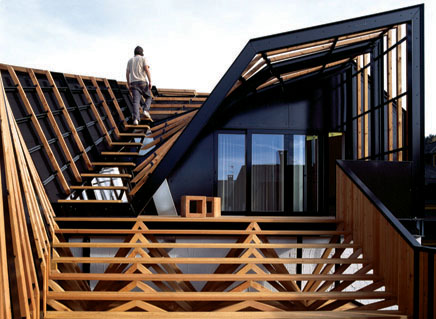
Esker Haus , San Candido, Italy (2006) Plasma Studio
We were thinking for the house I had shown in the lecture, the Esker Haus , that the interior would be plastered totally smooth, because we weren’t quite sure about the definition of the edges and how that would actually translate through the difference in construction systems—where we were using prefabricated panels. In this way, the inside was going to be all smooth and the outside have all these facets, which would be kind of cool on its own. But then upon seeing the inside being quite beautifully faceted, I was quite happy it was not smooth. And another thing (this is obviously a question I get asked quite a lot) I can never picture what you can do in the corner. It always immediately becomes the weak point. You can do the smoothness nicely in one direction only, but when its everywhere then it becomes really muddy and doesn’t have a conceptual trail.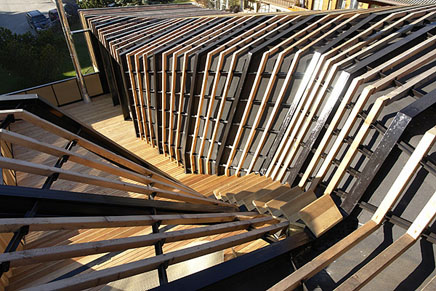
Esker Haus , San Candido, Italy (2006) Plasma Studio
We really try and create something that is seamless and integrated. For instance, the corridor spaces for Hotel Puerta America , somebody else might have done that project totally smooth, but then the doors would have been cutout of this container. There would be a clear definition that this is the skin, this is the smoothness, and these are certain other objects which are not a part of this—automatically because the door has a certain geometry that is contrary to the system. But with us it’s all pleated. The doors are part of that system and the floor as well. In that sense, it’s much smoother as everything is part of the same geometry.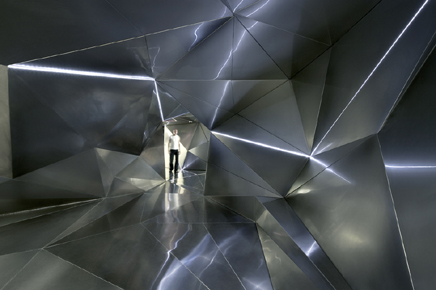
Hotel Puerta America , Madrid (2005) Plasma Studio
19:24 jourden:// In your mission statement you talk about the impact and polarization of media and iconography in architecture where architecture is being changed because of these attitudes or positions—you’ve moved into such a direction where you're consciously trying to avoid this, but is that even possible?
20:20 kehne:// I think it’s an ambiguous field and that makes it kind of interesting. As long as one is concerned about it and aware of it, then the ambiguity is not a problem. There is not a definite position I think. People who are really working with this kind of iconography in mind, or these kinds of big ideas, and then doing Koolhaas deciding to have yet another brilliant idea of just doing something, is what I find problematic. What they don’t see, critically, is that the way they are using it becomes a bit flat.
I must say it is certainly important that buildings have a way of being identifiable, but it shouldn’t determine the way they operate. The way they operate or what they actually do should obviously be important. Now you might use iconography as a way of getting that other financial side of things going and being really smart you might create a third methodology. You should, however, not totally ignore the way a building functions socially and critically—in its capacity of changing conceptions, changing social patterns, or integrating people socially. All these intentions are highly paramount and the image really distracts from that. Like nowadays it’s really just about how it looks and people are much more concerned about that than anything else. This is really what I am referring to in that paragraph, and we’re putting so much effort into not just creating visual effects, but to really to create a new kind of space.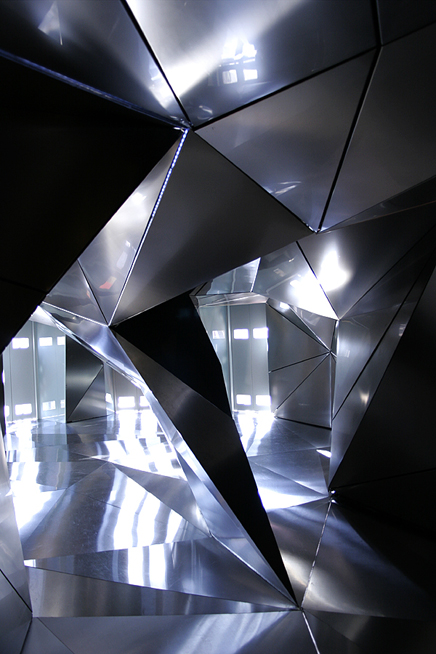
Hotel Puerta America , Madrid (2005) Plasma Studio. Photograph by Ludwig Abache
23:08 jourden:// Do you think though that this new terrain gets created by these relationships between what we were just talking about—iconography and media and how they sort of play these things into instantly gratifying images which even fall into the realm of smoothness, right? Where (architecture) becomes more like product design, just creating something to be seductive. What is the implication of that to practice for young firms and also as sort of pedagogically way? Because obviously there is something you need to explain to students that are constantly being seduced and bombard by the presence of the “starchitect.”
24:27 kehne:// We are really working into the students’ mind a certain solemness towards how to analyze, what constitutes a particular site, to really engage with what is actually going on, and to format a critical proposal. It’s also fortunate that the tendency at the AA is not really directed toward images so much, but more about processes in discovering new tools used to propose new spatial constellations, or maybe even new conceptual propositions. It usually operates under a more substantial criterion and less on flashy images or great presentations. (Students) really have to smarten up on this as well, because everyone else is doing it actually. And there is a big gap at the moment between what the students are producing and what is actually happening in their work. It’s not healthy, I think. It has to move closer together so that the students can really also contribute to a healthy architectural discourse, which at the moment is not really happening in the UK.
In some ways at the AA it’s almost the opposite. It is really a bit of an ivory tower and the students are doing really interesting stuff that looks much more like mathematics or some sort of physical experimentation. Projects with a lot of data and a lot of diagrams and everything in line drawings. Often they don’t quite get to making a point by putting these concepts into something that can be scrutinized. All these serious things sort of stand for themselves. But when you start making a proposition for a tangible thing, that is actually quite brave and I very much encourage them to do so. It’s less about doing a beautiful building—it’s about proposing something that has a certain power. Not just to seduce, but to make a certain statement. I think it’s really important to do that. Just looking at the answer from a slightly different angle and try and turn it into something positive.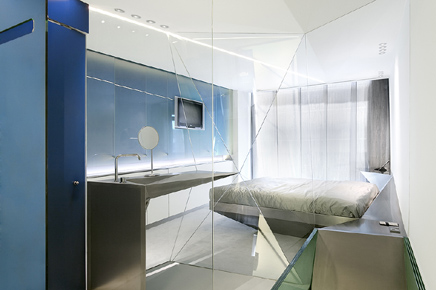
Hotel Puerta America , Madrid (2005) Plasma Studio
29:18 jourden:// How long have you guys had another office in Italy now?
29:26 kehne:// Since 2003…
29: 31 jourden:// I see. Does having two offices give you more leverage as an emerging practice in arranging yourselves in the European context to get more work?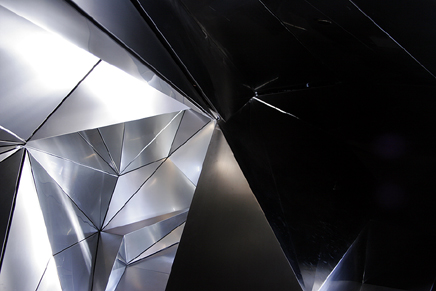
Hotel Puerta America , Madrid (2005) Plasma Studio. Photograph by Ludwig Abache
29:41 kehne:// I think it’s good. This area is an overlap between the Italian and the German-speaking world which is really quite good for us, because from there we have quite good links into Austria and Germany. This is at a moment where we are trying to expand more from—a Central European position as opposed to from London, which is a more global place from where to project. And gives us quite a bit of connections in terms of emerging markets around the world. I imagine if we wouldn’t be in London and just in Italy we wouldn’t be sitting here right now I guess…we wouldn’t have gotten the project in Madrid (Hotel Puerta America), so for us it’s a brilliant combination really. In Italy, we get some really interesting local projects, plus connections with some very innovative companies that we have spoken with and who are interested in our ideas and new ideas really. We hope something will come out of that in the future. It is working quite well in that sense, which is something I didn’t necessarily expect…
31:35 jourden:// I know we want to get going, so I’ll just ask you one other question. It’s starting to get twilight and we’re going to miss the architecture here. What would be some advice you would offer to young architects today who are coming out?
32:01 kehne:// If they’re already architects then it’s obviously too late to say "think about it to see if you really want to do it," because if you don’t want to make that commitment you might as well choose another career. It is really painful, it doesn’t pay well, so you have to love it and give it a go. And if you love it you will obviously want to take the leap—take the opportunity and make the jump.
It sounds kind of great to have your own practice and I’m sure there are other ways in this world to make good contributions and to develop certain ideas and so on. Having your own practice is kind of hard, particularly in the beginning. So if people want to do it, I would encourage it, but they really have to have a long breath and have to make a total commitment to it! Maybe they’re lucky, they’re rich or something, then they might have a different type of experience. It is very very painful, very long, and involves many years of hardship. You have to kind of get through that really and that is something which is quite difficult. [laughs] That sounds like a grandfather really. It’s funny! [laughs]
33:48 jourden:// Well you’ve got to represent the hardships, because people don’t always understand…
33:53 kehne:// Definitely, if they really go and do it, they have to really say, well the next five years are going to be good enough for me. [laughs] It’s about bringing this attitude to slowly roll really and not much else, but hard and productively. It’s really well-worth it if you love what you do.
34:14 jourden:// Right on. Thank you very much.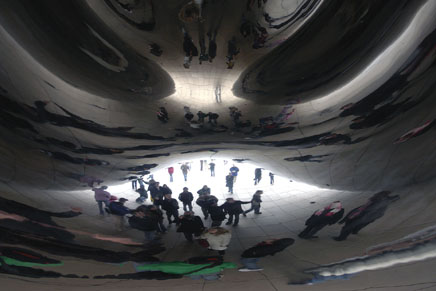 Beneath Cloud Gate in Chicago on November 11, 2006 Photograph by Holger Kehne
Beneath Cloud Gate in Chicago on November 11, 2006 Photograph by Holger Kehne
Creative Commons License
UpStarts is licensed under a Creative Commons Attribution-NoDerivs 2.5 License .
/Creative Commons License
2 Comments
They presented their work at my university (UEL) and their work was amazing they where also very helpful and inspirational, I'm happy to see that they're doing so well.
Good interview, and very informative. UpStarts always give us a little insight about things we also encounter and other things we should avoid as well. Good Job!!
Block this user
Are you sure you want to block this user and hide all related comments throughout the site?
Archinect
This is your first comment on Archinect. Your comment will be visible once approved.